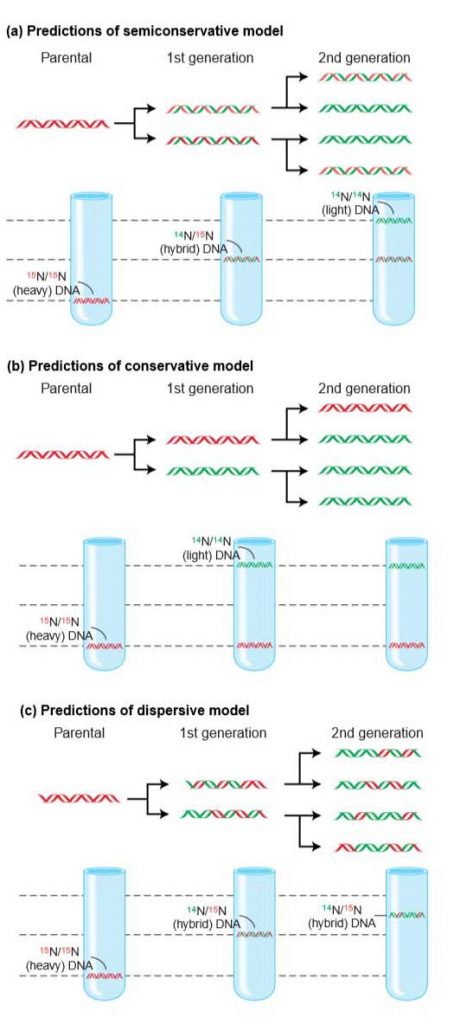The first problem in understanding DNA replication was to figure out whether the mechanism of replication was semiconservative, conservative, or dispersive.
In 1958, two young scientists, Matthew Meselson and Franklin Stahl, set out to discover which of these possibilities correctly described DNA replication. Their idea was to allow parental DNA molecules containing nucleotides of one density to replicate in medium containing nucleotides of different density.
If DNA replicated semiconservatively, the daughter molecules should be half old and half new and therefore of intermediate density.
To carry out their experiment, they grew E. coli cells in a medium containing the heavy isotope of nitrogen (15N) rather than the normal light (14N) form.
This isotope was inserted into the nitrogen bases, which then were incorporated into newly synthesized DNA strands.
- After many cell divisions in 15N, the DNA of the cells were well labeled with the heavy isotope.
- The cells were then removed from the 15N medium and put into a 14N medium;
- after one and two cell divisions, samples were taken and the DNA was isolated from each sample.
Meselson and Stahl were able to distinguish DNA of different densities because the molecules can be separated from each other by a procedure called cesium chloride gradient centrifugation. If cesium chloride is spun in a centrifuge at tremendously high speeds (50,000 rpm) for many hours, the cesium and chloride ions tend to be pushed by centrifugal force toward the bottom of the tube. Ultimately, a gradient of ions is established in the tube, with the highest ion concentration, or density, at the bottom.
- DNA centrifuged with the cesium chloride forms a band at a position identical with its density in the gradient.
- DNA of different densities will form bands at different places.
- Cells initially grown in the heavy isotope 15N showed DNA of high density. This DNA is shown in red at the left-hand side of Fig 1.
- After growing these cells in the light isotope 14N for one generation, the researchers found that the DNA was of intermediate density, shown half red (15N) and half blue (14N) in the central part.
- After two generations, both intermediate- and low-density DNA was observed (right
hand side of Figure 1), precisely as predicted by the Watson–Crick model.

Fig 1 The Meselson-Stahl experiment demonstrates that DNA is copied by semiconservative replication. DNA centrifuged in a cesium chloride (CsCl) gradient will form bands according to its density. (a) When the cells grown in 15N are transferred to a 14N medium, the first generation produces a single intermediate DNA band and the second generation produces two bands: one intermediate and one light. This result matches the predictions of the semiconservative model of DNA replication. (b and c) The results predicted for conservative and dispersive replication, shown here, were not found.